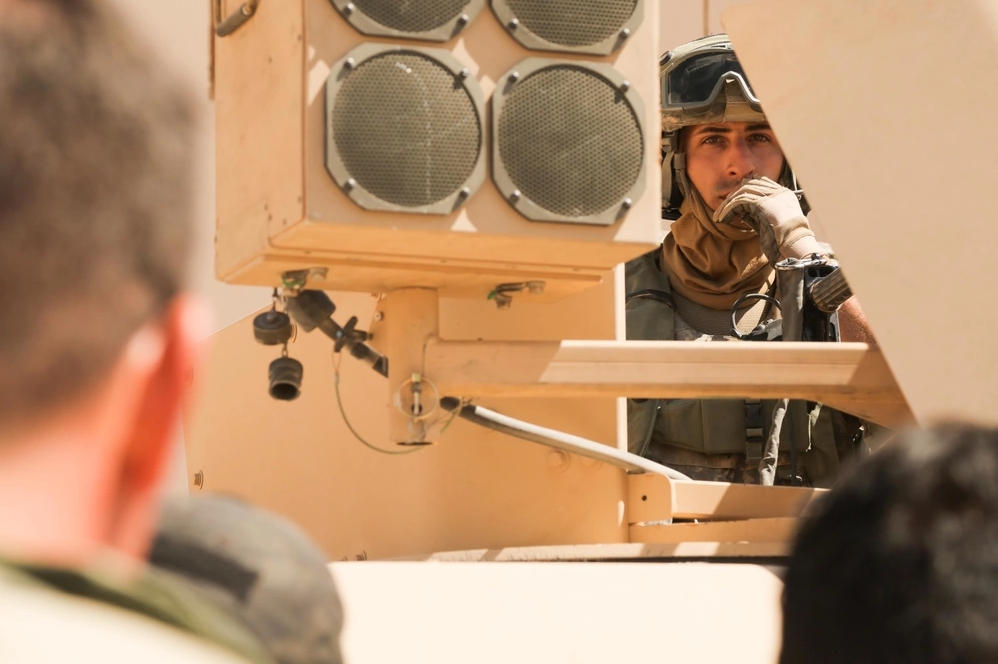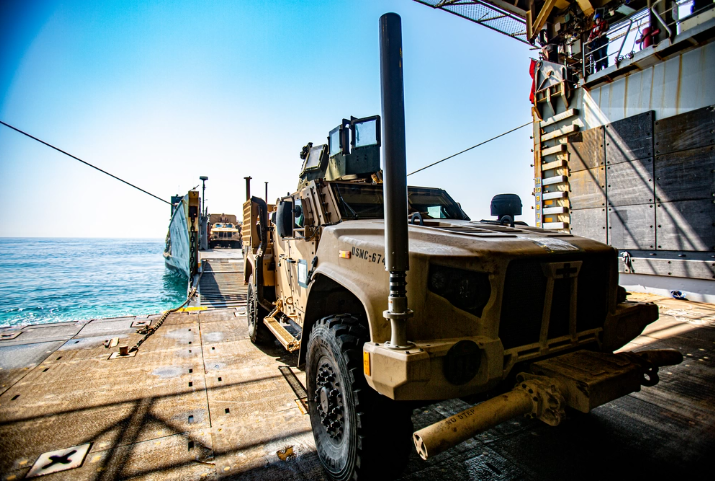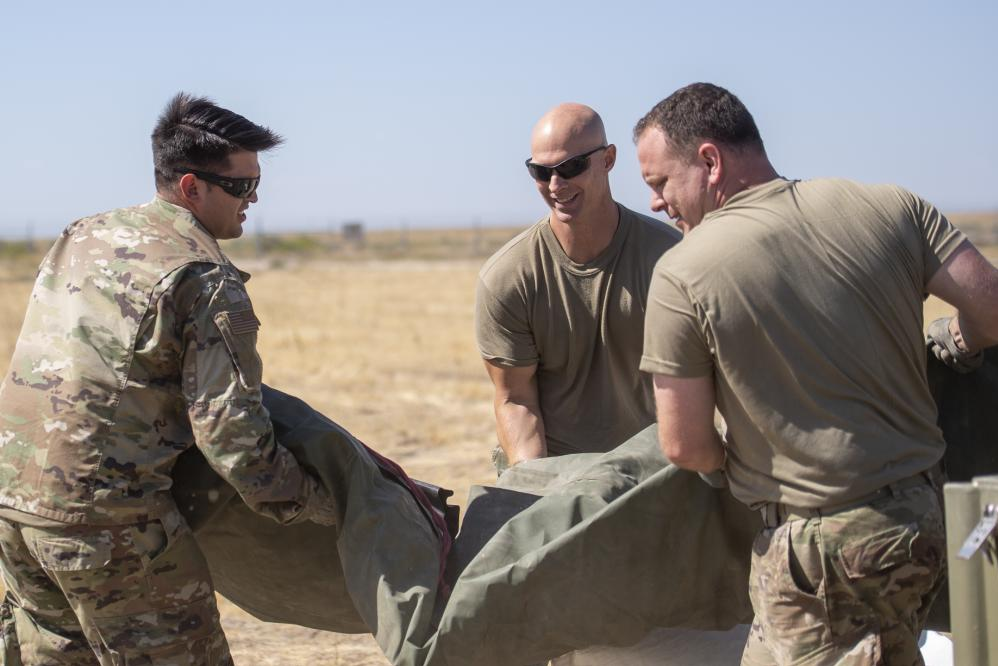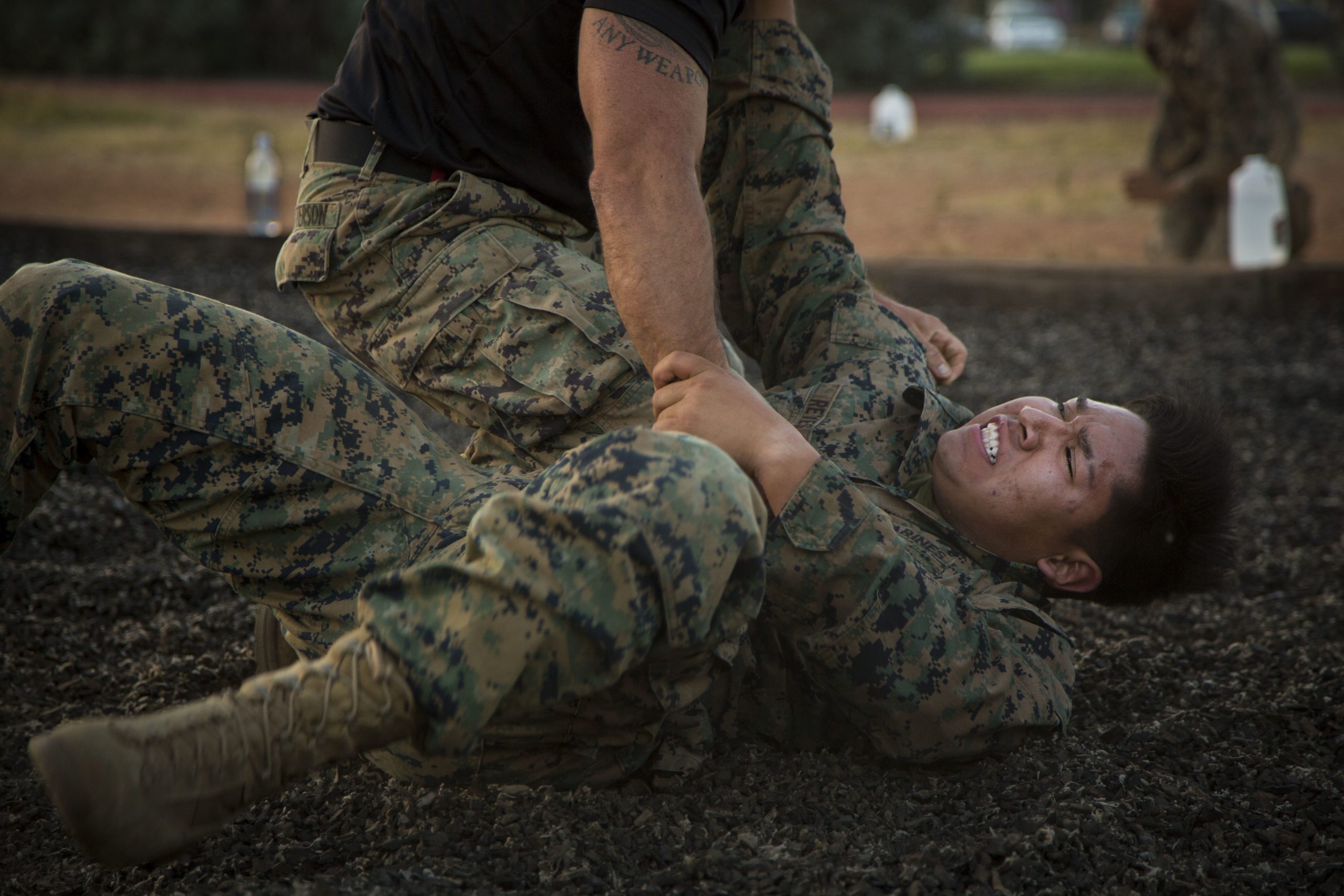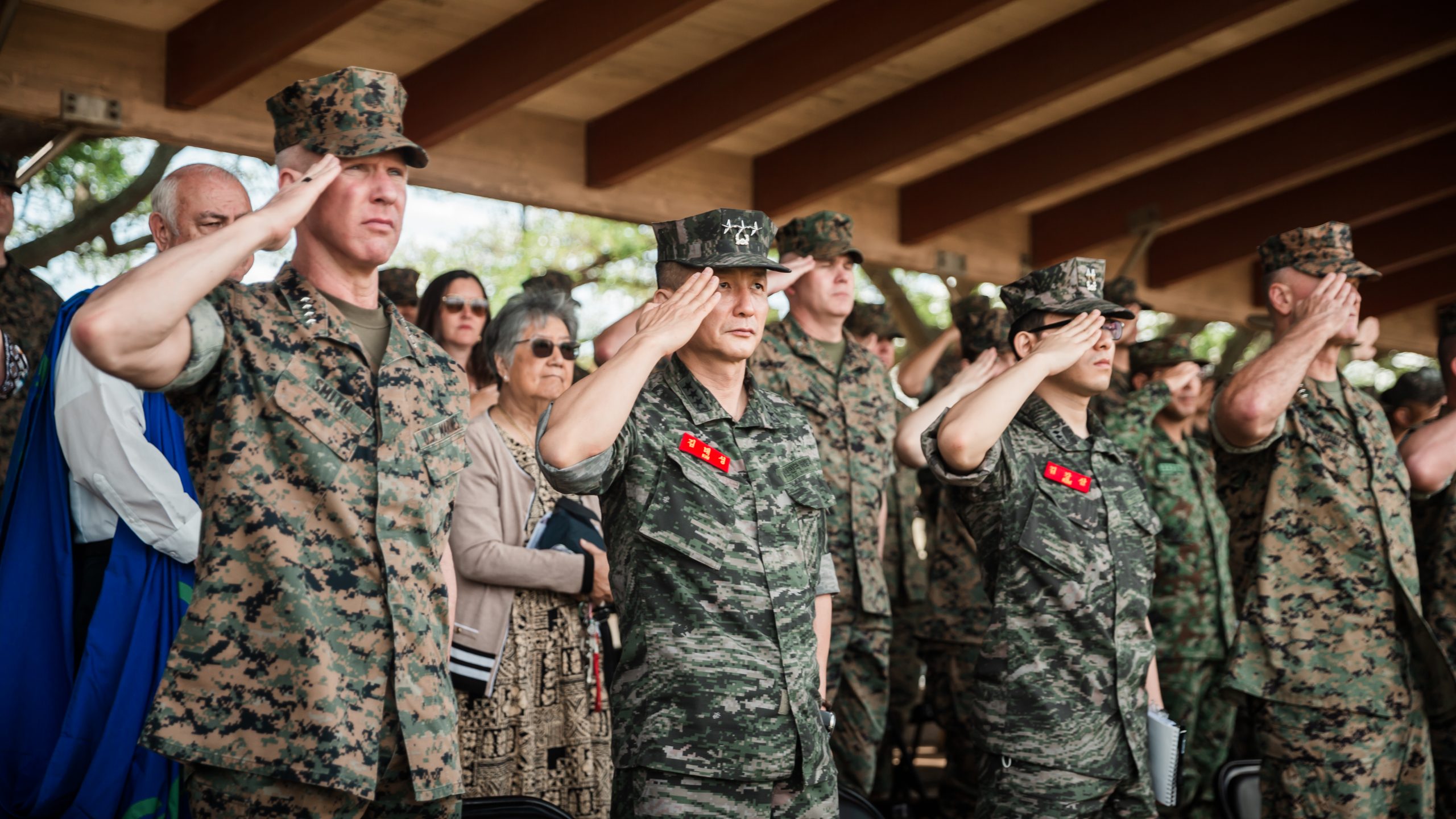Lessons from three dreams
>LtCol Haycock is an 8061 Acquisition Professional serving as the Program Management Team Lead for Terrestrial Collection and Human Intelligence programs at Marine Corps Systems Command in Quantico, VA.
My name is Capt Alfonzo, but everyone usually just calls me “Captain A” for short. I command Alpha Company, 1/1 Mar. It is my first month in command having recently arrived on a ship deployed in the vast ocean east of Guam. I admit I have little experience in expeditionary advanced base operations, especially command and control by radio communications, but my Marines are mature, well-led, and well-trained. I am going to tell you the story of how I learned thirteen principles of radio communications during our assault on Duffer’s Island.
It was a cool pre-dawn hour when the reconnaissance element radioed back to the embarked battalion that we will meet minimal resistance when we assault the airstrip the following night. The objective was to clear and occupy an austere airfield named Via Saltu on tiny Duffer’s Island, located twenty miles off the coast of the allied Grey Republic. The Grey Republic, as we all know, was narrowly resisting outright domination by the treacherous Democratic Federation of Reds. The end state of our company landing team’s mission was to establish a temporary fueling and rearming point for our valiant Blue Nation pilots on Duffer’s Island as part of a surge of air superiority toward the landing force’s final objective during this stage of the campaign. By the end of the following day, Company Landing Team A owned Via Saltu Airfield, and the landing force established a forward arming and refueling point (FARP). But first, we flew by means of two flights of four Ospreys each to a clearing three miles south of Via Saltu airfield. Because I had 24 hours to prepare for my first company landing team assault, I gave initial guidance to the company operations officer to continue with preparations and then slept in hopes of drawing from my subconscious an approach to radio communications that would help us be successful in the coming operation.
First Dream
As the sun crested the jutting slopes of nearby jungle hilltops, the shadow receded in favor of jagged light, illuminating the landing zone (LZ) now certainly clear for landing. Through the night, the reconnaissance element had scoured the LZ and its surroundings. There were no threats or observers of any kind, human or otherwise. No flights of aircraft of any type were observed near the island. It appeared the landing would be entirely unopposed.
However, as the first four aircraft landed at the clearing, an enemy missile struck the first Osprey. Its destruction was sudden and catastrophic. None of the sixteen passengers and crew survived. As the other missiles struck the landing zone, a second aircraft with the remainder of 1st Platoon was also hit creating a mass casualty problem for the rest of the landing force. When 2nd Platoon landed in the third and fourth Ospreys, they were faced with competing requirements to evacuate the kill zone, establish a defensive perimeter, and provide aid to the wounded. Missiles kept pounding the LZ, one after the other, killing or wounding 42 out of 64 members of the landing force’s lead element. When the eight-missile barrage ended, Lt Secundus from 2nd Platoon took stock of the situation. With downed aircraft, mass casualties, an unseen enemy, and less than a quarter of its strength, the company landing team was, for the time being, combat ineffective.
Being short two aircraft, the remainder of the company landing team was delayed by several hours in reinforcing Lt Secundus’ isolated platoon—time in which the Red force was able to position its naval forces near the island and actively deny Blue force entry into its air and sea space. Without reinforcements, 2nd Platoon would have to evade or defend against the Red force alone for an indefinite amount of time.
I was bewildered as to how the enemy could have known the exact grid location on which the Osprey was going to land. The recon element observed no enemy spotters or other intelligence collectors in the area. The grid location was only briefed to the pilot by the recon element fifteen minutes earlier when the aircraft checked in to make its approach. After talking with the surviving pilots when they returned from the day’s flying, they reported that they attempted to use encrypted comms on their primary net, but it was not working like it did the previous week. They had switched to an emergency radio frequency—one that was unencrypted for safety reasons.
Perhaps the Red force had been observing our Ospreys with electronic warfare systems and had noticed the same single frequency used for every flight. Because they could detect the strength of the signal, but not the information it carried, they likely deduced that it was our encrypted assault support intra-flight net. Listening from anywhere in the battlespace within a couple of hundred miles of the aircraft, it is easy for the enemy to hop on its own radios and transmit noise on that same frequency. Perhaps the enemy has purpose-built jammers somewhere in the region, or even a spacecraft in low orbit, that can transmit so much noise on that frequency that the Osprey’s intra-flight radio net was effectively jammed, forcing the pilots to find a different net to operate on for today’s mission.
Perhaps there was a signals intelligence aircraft somewhere in the airspace or signals intelligence collector on the ground of a nearby island that was able to listen to the secondary radio net; the unencrypted, single frequency radio transmissions between the recon element and the pilot, or between the pilots, when the grid location of the LZ was stated: “in the clear.” With a modern networked radio relay, the grid location was given from the enemy’s intelligence collectors directly to the fire control system of the Red force’s missile battery, and the command was given for launch. The five or six minutes of flight time from the missile battery’s location was short enough to catch the lead Osprey before its wheels had even contacted the clear LZ.
As I woke from this first dream, the following three fundamental rules about radio communications came to my mind:
- Rule number 1: Any radio net that relies on a single frequency for long periods of time is susceptible to simple jamming, also known as narrowband jamming. Use radio nets that hop between multiple frequencies whenever possible. Think SINCGARS and HAVEQUICK.
- Rule number 2: Always encrypt your voice communications. In the contested environment, only communicate in the clear those things you intend on being heard by the enemy.
- Rule number 3: If you must resort to the use of an unencrypted radio net, establish a set of brevity codes that helps you communicate without being understood by the enemy.
Second Dream
The situation and mission of the company landing team’s insertion onto the island of Via Saltu airfield by two flights of four Ospreys each remains the same. However, I was compelled to ensure the lessons of the first dream were enacted in the planning and execution of the current dream. I called to make certain that the aircraft carrying my company into the assault had been prepared with sufficient radio communications to evade such early enemy detection and interception. The assault flight lead, Capt Alex Franklyn Larson, assured me that they now had four encrypted frequency hopping nets to communicate both internally and with the recon element guiding them to the LZ. This way, they would be resilient to simple jamming by the enemy. We also agreed to a list of brevity codes to communicate in an emergency over unencrypted nets. The execution checklist for the mission also incorporated these brevity codes. With a short rehearsal, we were able to practice saying “Chevrolet” instead of “LZ is clear for landing” or “Plymouth” instead of “landing force has reached the objective” and other such codes.
As the Ospreys approached the island, the recon element provided the ten-digit grid over an encrypted frequency hopping net and both were confident the enemy Red force had not jammed or intercepted these coordinates. When the first flight of Osprey’s arrived in the LZ, the Marines of 1st and 2nd Platoons landed safely and unopposed according to their planned and rehearsed actions on the objective. While awaiting the second flight of Ospreys that would carry 3d Platoon and other enablers, like engineers, aviation ground support, and stinger missile gunners, Lt Primus of 1st Platoon established a company command post at the top of the nearest hill to get the best radio communications with the company landing team platoons, the battalion, and the MAGTF. They used standard foot-mobile radios such as the PRC-117G VHF and UHF radio and PRC-150 HF radio. They were also practiced in digital communications such as KILSWITCH and tactical chat over wideband radio capabilities like adaptive networking wideband waveform (ANW2). Almost every radio antenna was vertical to make sure that the radio propagation patterns could provide radio coverage to the whole area in 360 degrees (known simply as omnidirectional) and powered to the highest setting so they could reach as far away as possible. They also had access to standard UHF SATCOM to come up on the battalion command net. Finally, they also had commercial satellite telephones and friendly force trackers such as the Shout Nano.
Over the next two hours, Lt Primus did well to establish security, radio back to the company and battalion of the situation, and make other decisions vital to the continuation of the mission. Just as the second flight of Ospreys landed bringing myself and 3d Platoon to the LZ, there was a horrific explosion in the direction of the company command post. After talking continuously by radio to the local area and to higher over the last two hours, Lt Primus and his radio operator were fatally wounded by a missile strike. Recognizing the need to relocate the command post to another location, I took charge of the company and established a new company command post 800 meters away, where the radios could be placed at the top of a different piece of high terrain, according to the unit SOP. After all, we fight like we train.
After setting up communications at the new company command post in the new location and starting a routine of scouting patrols (each with routine radio checks and detailed situation reports), two large airplanes were spotted in the sky, both in the direction of the Grey Republic where we most expected to see the enemy. After calling over the radio to tell the scouting patrols what we saw and to lay low, a horrendous explosion obliterated the command post with fire and debris until there was nothing left but a smoking hole in the hilltop. The radio operators and the mortar section were instant casualties, and I was badly wounded. As Lt Secundus of 2nd Platoon responded and attempted to organize the company, the enemy jets came. Four hours after we landed, we were being gunned down by the enemy fighter jets making pass after pass on our position until they apparently ran out of ammunition. After sustaining 30 percent casualties and 12 hours of doing our best to prepare a deliberate defense of our position, a message came over our radio that informed us that the Red naval force had reoriented itself on Duffer’s Island and that lack of air and surface superiority would force us into isolation for the foreseeable future. We should prepare for an enemy ground assault based on our last position and that an Army airborne battalion might be able to drop in a few days. Until then, we were to maintain radio silence for our own safety.
As it turned out, our omnidirectional antennas were emitting radio signals in all directions, even toward the enemy. Because we wanted to ensure that each radio could talk with certainty, we made sure that radios were set to their highest power setting, regardless of the distance between them. Perhaps the first missile strike came as the result of enemy signals intelligence aircraft triangulating our position based on the large volume of encrypted radio communications coming from it. All it takes is two or three enemy direction-finding radios to pinpoint a friendly radio—or perhaps even just one aircraft flying around the island taking many measurements of the radio signals that reach it over a period of time. Those aircraft we spotted were probably some of the same ones triangulating our position after the first half of the company landed, and they probably also determined the actual coordinates of our radio emitters. Given the large number of encrypted radio signals across many parts of the spectrum coming from our location, the enemy probably deduced that we were a company command post of relatively high value, at least valuable enough to expend two medium-range GPS-guided missiles and to maneuver the naval force in pursuit.
As I woke from this second dream, the following three fundamental rules about radio communications came to my mind:
- Rule number 4: Use terrain masking to prevent radio emitters from radiating toward the enemy force. If an omnidirectional antenna must be used, do not place it atop prominent terrain features where it will radiate toward the enemy.
- Rule number 5: When able, use directionalization techniques to reduce the amount of radio signal that can go where the signal is not needed. A vertical radio antenna has a cone of silence directly above it (and below it). To avoid detection by the enemy, the enemy must be directly above the antenna. However, a horizontal radio antenna’s cone of silence is to its left and right, effectively giving it a single azimuth of radiation towards its destination and incidentally from the transmitter backward away from the intended destination. This means that an enemy signal collector could be on the left or right side and not be able to detect the presence of a radio signal. Note: Use directionalization wisely because it requires all radio operators to know their positions, azimuths to their intended targets, and often extra time to set up and tear down elaborate antennas.
- Rule number 6: Use the minimum power setting that will allow you to talk between the two locations that matter to you. Do not let stray radio signals be strong enough to be observed by the enemy unless necessary.
Third Dream
The situation and mission of the company landing team’s insertion onto the island of Via Saltu airfield by two flights of four Ospreys each remains the same. However, I was compelled to ensure the lessons of the second dream were enacted in the planning and execution of the current dream. During this dream, after landing safely in the LZ on Duffer’s Island, Lt Primus established the tentative company command post on a piece of terrain that masked his radio transmissions from the direction of the enemy, essentially a stone wall in the hillside that blocked the directions of northeast, north, and northwest. I was briefed that Blue forces had general air superiority to the south. This hill was still elevated enough to provide radio coverage to the company and back to the battalion and the MAGTF. Consequently, the stone wall in the hillside had reflective qualities, so more radio power than usual was available to the company to the south coverage area. That means that the radio operators were all able to lower the power settings of their radios and still maintain communications.
For those forward patrols to the north that could not be reached by the command post radios oriented to the south, they were provided with a directionalized radio, either a horizontal HF skywave antenna where the direction of the radio signal is obscured by the atmospheric scattering, or with a horizontal VHF or UHF antenna aimed directionally toward intended recipients. In the latter case, enemy signals collectors had to stumble onto a particular azimuth in their flight pattern to observe any of our stray signals, and their access to observe our signals would end rapidly unless they were flying directly toward us. This also meant that before departing for their patrols, squads would have to prepare a full five-paragraph order, plan a scheme of maneuver, build terrain models, and brief their plans, both internally and externally. The company radio operators had to know where the patrols would be and when so that coverage areas could be moved over time according to the changing azimuth from the command post to the patrol.
Next, each radio operator was tasked to reduce power settings as often as able while still communicating. In summary, we were very disciplined about limiting our radios to only radiate in directions and at minimum power levels necessary for us to talk.
As the company landing team’s patrols scouted ahead toward the Via Saltu airfield, communications were outstanding. Patrols were able to provide situation reports every 30 minutes after pausing to set up their directional antennas.
After twelve hours on the island, the scouting patrols had viewed the airfield, identified key terrain (as marked with ten-digit GPS grids), and brought back enough information to prepare for the company assault. However, problems started occurring as the mortar section chief inquired about potential targets in and around the airfield.
When asking for information from the reconnaissance and scouting patrols that had eyes on the objective, the scouting patrols were unable to report on grid coordinates of nearby terrain features. Their GPS receivers stopped working. When reporting this back to the company, it became apparent that our standard means of radio communications also stopped working. VHF frequency hopping nets were suddenly garbled and unreadable, all of them. It was a very strange phenomenon indeed—one never experienced by our radio operators in training. When resorting to various frequencies, configuration settings, and even radio types, it seemed that they would work for about fifteen minutes and then fall apart. With as much resilience as we had planned for in our radio communications, we seemed to be getting jammed across all of our communications systems. The only system that worked was UHF narrowband SATCOM radio. Through it, we received a report that the Red naval force has obtained air and surface superiority in our vicinity. At the same time we received this information, the shelling began.
The shelling was not accurate; beginning at first a few hundred meters south of the LZ on which we landed, but it was walking closer and closer to the company command post. We could only assume that they planned to barrage the whole island in preparation for a sweep and clear operation to find us. We couldn’t communicate. We were strung out over three miles of various terrain. We were isolated and unsupported. The best we could do was send runners to the last known grids of the patrols and consolidate our company to a defensible position. While the terrain provided fair cover and concealment, the loss of local air and surface superiority meant that we were going to be in a truly dire situation. Food, water, and ammunition would deplete unless resupply and reinforcements could be arranged and delivered through enemy lines. Our casualties would not be quickly evacuated if at all. Our defensive indirect fire was limited to our company mortars and grenades. Engineers were not equipped to build the defenses necessary to stop the looming enemy assault. It was a truly dire situation indeed.
After a week-long defense of the company command post, our dug-in fighting positions were void of all vegetation, thanks to incessant accurate shelling. The company, while valiant, was reduced to 25 percent effectiveness due to casualties by enemy fire and a lack of food and water. We suspected that the enemy had no reason to assault our position and risk their own personnel rooting us out. They had us surrounded and isolated.
All they had to do was wait for us to surrender or perish due to lack of water. They had won.
In those dreadful hours awaiting death or capture, I pondered how the enemy knew that we were doing something of such strategic importance that they were willing to maneuver their naval forces to a position to gain air and surface superiority. Perhaps stray signals that made their way off the island established a suspicious pattern to signals intelligence collectors. It stands to reason that a major industrialized nation like the Democratic Federation of Reds could produce a broad-spectrum jamming capability—essentially blasting radio noise on all our VHF frequencies at the same time. Then whenever we would stray from our standard frequencies and try something new, they would listen for it, locate it, and adjust their jamming to also stamp it out too. They seem to have combined air superiority—and perhaps space superiority—and electronic warfare to make possible complete information superiority. They are able to have unfettered access to information while effectively denying our own use of information. Looks like it is back to the Stone Age for us.
As I woke from this third dream, the following six fundamental rules about radio communications came to my mind:
- Rule number 7: Do not transmit radio signals unless absolutely necessary. To radiate is to be detected, to be detected is to be targeted, and to be targeted is to be destroyed. Though we have taken measures to reduce how much of our radio signal can be observed by the enemy, we cannot control various scattering and reflections from eventually reaching enemy sensors. Unnecessary situation reports and excessive radio checks serve to provide small pieces of evidence to the enemy. The less we transmit over radios, the fewer pieces of evidence the enemy has to collect, and the longer we can delay the inevitable localization of our radios.
- Rule number 8: While there should be no limit to transmitting radio signals in support of fires and CASEVAC, other routine radio communication should be limited to pre-arranged periods of time, also known as comm windows. When given a small, prearranged window of time to transmit on radios, small units are forced to save their information to be passed in very short bursts, perhaps two or three minutes. Should the enemy find a friendly radio frequency to observe, they will not have enough time to triangulate its position. They also will not be able to deduce the size or capability. The next time the small unit uses that frequency, they are hours and perhaps miles away. Prolonging the time it takes for the enemy’s inevitable identification of your radio traffic and subsequent deduction of your strength or intentions allows you more time to complete your mission free from harassment or interdiction.
- Rule number 9: GPS can and will be jammed. Use encrypted GPS for positioning (and timing) information that is more resilient to enemy jamming. Also, it goes without saying, always be proficient in navigating without GPS.
- Rule number 10: Be mindful of your radio signature and frequently change it as the situation permits. Where a mechanized infantry battalion looks much different to imagery intelligence collectors from a heavy-lift helicopter squadron, so too will they look different to signals intelligence collectors. Where one uses predominately VHF communications and the other uses predominately UHF communications, both create a radio signature useful in deducing what types of units are operating where. Do not be afraid to reverse their signatures temporarily to confuse the enemy. Note: There will be technical limitations and operational impacts in doing so. Each limitation or impact must be evaluated carefully.
- Rule number 11: Be deceptive in your use of radio communications. When you are large and want to appear small or non-existent, exercise as much radio silence as your situation permits. However, if you want to appear large and are small, you can make a concerted effort with your forces and radio assets available to spread out across the area of operations and create an exorbitant amount of false radio traffic. Use tall antennas on high power settings to make sure the enemy can detect the presence of every radio transmission.
- Rule number 12: Be unpredictable in how you use radio communications. Given enough time and resources, anything you transmit can be detected, jammed, and targeted by the enemy. You must exercise full use of the wide range of communications capabilities in an unpredictable way to outpace the enemy’s electronic warfare efforts. On one day, use VHF and UHF if speed is required and the terrain permits. On the next day, trade VHF assets for HF assets as the situation permits. On the next day after that, resort to satellite phones and brevity codes, or runners, or flags, or pen lasers, or field phones and cable, each as the situation may permit.
- Rule number 13: Above all else, be brilliant at the basics. All small unit leaders must prepare their five-paragraph orders with an understanding of the commander’s intent two levels up. Use terrain models. Communicate the plan and get brief backs. Conduct pre-combat checks and pre-combat inspections. Have a robust and well-thought-out no-comm plan. Know the schemes of maneuver of all your adjacent units. Have a well-informed runner that can find other small units on the battlefield. Finally, train your people to act well in absence of clear direction and in accordance with the commander’s intent. Then trust them without micromanagement. With all these basic elements in order, most radio communications need not be used until the decisive point in battle.
As I returned to my fully conscious state and these thirteen rules of radio communications manifested solidly in my mind, I returned to the company planning spaces and endeavored to ensure that all of these rules could be applied to the coming operation.
Small-unit leaders were instructed to limit radio traffic to those absolutely necessary for fire support coordination, casualty evacuation, or to make a change to the scheme of maneuver as briefed. Small-unit leaders on patrol were further instructed to reserve all of their routine radio traffic for a single five-minute comm window every three hours, and such comm windows would be made using random assignments so that it would be difficult for a three-hour pattern to emerge for the enemy to recognize. Additionally, no comm windows were allowed to be made from locations within 800 meters of any previous one. The company command post would similarly displace as often as the situation permitted. Details of such displacements would be communicated and updated azimuths to new locations would be made for directional radios.
Next, GPS devices were provided encryption keys so they could access more resilient GPS services reserved for Blue nation military units. This did not prevent platoon commanders from ensuring that all squads had sufficient maps and compasses to navigate absent of GPS.
Then, we came up with our radio signature management plan. We decided that we would use two VHF frequency-hopping nets for our primary and alternate comms as the first flight of Ospreys arrives at the LZ. Frequency-hopping UHF nets would be reserved as contingency and emergency comms. The second flight’s spectrum signature would be reversed. When the first half of the company established a command post and started patrols, for the next eight hours, primary communication would be made by runner. No two positions were more than four miles away, and only fires, CASEVAC, and changes to the scheme of maneuver as briefed would be the only information exchange requirements so urgent that a runner would not suffice.
For the subsequent eight hours, those sparing radio communications necessary would be made by HF skywave on the pause. During the following eight hours as everyone moved into position for the upcoming airfield assault, VHF frequency hopping would be the means of radio communication. For now, ANW2 would be turned off because every radio on an ANW2 network emits a constant ping like a homing beacon searching for connections to make automatically. While this does hurt digital fires and KILSWITCH data exchange, it does prevent the enemy from locating every squad equipped with an ANW2 radio. Finally, during the assault, all units will talk primarily by UHF frequency hopping. This will be convenient because as soon as the airfield is under friendly control, the first C-130 carrying the FARP aviation ground support equipment will arrive and offload, and we will be able to report the runway clear for landing.
After communicating these procedures to the team, my only regret is that we had not practiced in training a wide range of methods of radio communications so that we would be able to adapt to changes in the comm plan as quickly as we will have to during this operation. Instead, it will have to learn and do while under the stress of a no-fail mission.
In the final eight hours before crossing the line of departure, smart packs were republished with the new, more complex communications plan, but the radio operators and squad leaders all had a good handle on the dynamic changes they would make in the coming hours. We would figure out ways to make dynamic comm plan changes simple and easy to cope with after we get back. For now, it is game time.
As the company landing team infiltrated Duffer’s Island and for the first four hours, we were able to avoid using any radio communication at all. We requested the grid of the LZ to be provided before wheels-up so that transmission was avoided. The recon element reported the LZ clear for landing with a chem-light buzz-saw so that transmission was avoided. To indicate to the battalion that we had all arrived safely, I gave a pre-arranged thumbs-up to the pilot to relay when they get back. As for actions on the objective, the squads and platoons did according to their plan and their rehearsals. With encrypted GPS to guide them, navigating to their pre-arranged patrol bases was very simple, though some needed adjustment as the micro-terrain did not provide the preferred defensibility and concealment. Adjustments were all reported by runners in buddy pairs. The platoons and company were well enough informed on the changing situation.
Platoons eventually shifted from security patrols to scouting patrols to ensure there were no surprises awaiting us in our company assault on the Via Saltu airfield. The scouting patrols brought back plenty of grid coordinates of relevant targets for the mortars; a single guard post, a largely unoccupied barracks, a motor pool with a few dilapidated trucks, avenues of approach, visible micro-terrain from which to adjust fires, etc. The mortar section had no information requests when it came time to coordinate the assault.
During these eight hours, HF skywave antennas were used to communicate, but units would only be talking during their comm windows. The brevity code for “nothing significant to report” was simply “[platoon number] then Zulu.” However, there were important reports to make, and platoon commanders were as concise as possible, being certain to un-key the handset every four seconds or less.
As we proceeded into the final eight hours before the assault, everyone stowed their HF radios in favor of VHF radios to get back to frequency hopping as the operation got closer to the decisive phase. Radio discipline, brevity codes, and communications windows were still used if communication was necessary as the company massed in the vicinity of the objective rally point and support by fire positions.
In the final 30 minutes before launching smoke and illumination, we switched to the UHF frequency-hopping radios to add spectrum to the list of our many elements of surprise.
Units maneuvered. Fires supported maneuver. Units communicated implicitly, verbally, and over the radio when necessary. Marines exercised initiative in accordance with the commander’s intent. While we confronted token resistance, the airfield was captured because of our overwhelming relative combat power.
While the airfield occupants probably telephoned or radioed to report the situation, the C-130 carrying the aviation ground-support equipment was in-bound according to schedule. Fuel, bombs, and other enablers landed and made this airfield a forward arming and refueling point. When it came into operation an hour later, the F-35s surged into this airspace further than they had at any point in the campaign up to this point, made possible because we provided them a safe place to land, rearm, and refuel, and get back to safety at the end of the day.
With air superiority promised, surface superiority followed soon after.
Two days later, the FARP was still intact, and the mission was a complete success. However, we knew the enemy was looking for an opening to launch some GPS-guided missiles at our aircraft, fuel, or ordinance during FARP operations. As it turned out, our fleet’s cooperative engagement capability was very busy defending our FARP from missile attacks. It was only a matter of time before the enemy succeeded. The retrograde order came, and we packed up. As the MAGTF afloat passed nearby the island, we retrograded knowing that our infiltration worked this time on this island, and we were able to successfully surge striking power at the enemy. Next time, we will need a different approach as the MAGTF surges air and surface superiority toward some different aspects of the enemy’s war-making capability. They will be waiting.




